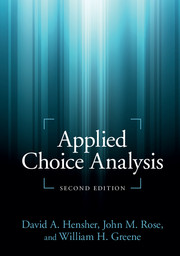Book contents
- Frontmatter
- Contents
- List of Figures
- List of Tables
- Preface
- Part I Getting started
- 1 In the beginning
- 2 Choosing
- 3 Choice and utility
- 4 Families of discrete choice models
- 5 Estimating discrete choice models
- 6 Experimental design and choice experiments
- 7 Statistical inference
- 8 Other matters that analysts often inquire about
- Part II Software and data
- Part III The suite of choice models
- Part IV Advanced topics
- Select glossary
- References
- Index
6 - Experimental design and choice experiments
from Part I - Getting started
Published online by Cambridge University Press: 05 June 2015
- Frontmatter
- Contents
- List of Figures
- List of Tables
- Preface
- Part I Getting started
- 1 In the beginning
- 2 Choosing
- 3 Choice and utility
- 4 Families of discrete choice models
- 5 Estimating discrete choice models
- 6 Experimental design and choice experiments
- 7 Statistical inference
- 8 Other matters that analysts often inquire about
- Part II Software and data
- Part III The suite of choice models
- Part IV Advanced topics
- Select glossary
- References
- Index
Summary
As far as the laws of mathematics refer to reality, they are not certain; and as far as they are certain, they do not refer to reality.
(Einstein 1921)This chapter was co-authored with Michiel Bliemer and Andrew Collins.
Introduction
This chapter might be regarded as a diversion from the main theme of discrete choice models and estimation; however, the popularity of stated choice (SC) data developed within a formal framework known as the “design of choice experiments” is sufficient reason to include one chapter on the topic, a topic growing in such interest that it justifies an entire book-length treatment. In considering the focus of this chapter (in contrast to the chapter in the first edition), we have decided to focus on three themes. The first is a broad synthesis of what is essentially experimental design in the context of data needs for choice analysis (essentially material edited from the first edition). The second is an overview in reasonable chronological order of the main developments in the literature on experimental design, drawing on the contribution of Rose and Bliemer (2014), providing an informative journey on the evolution of approaches that are used to varying degrees in the design and implementation of choice experiments. With the historical record in place, we then focus on a number of topics which we believe need to be given a more detailed treatment, which includes sample size issues, best–worst designs, and pivot designs. We draw on the key contributions in Rose and Bliemer (2012, 2013); Rose (2014); and Rose et al. (2008). We use Ngene (Choice Metrics 2012), a comprehensive tool that complements Nlogit5 and which has the capability to design the wide range of choice experiments discussed in this chapter, and to provide syntax for use in a few of the designs. We refer the reader to the Ngene manual for more details (www.choice-metrics.com/documentation.html).
- Type
- Chapter
- Information
- Applied Choice Analysis , pp. 189 - 319Publisher: Cambridge University PressPrint publication year: 2015
- 4
- Cited by



